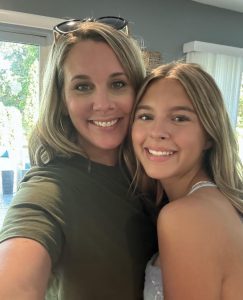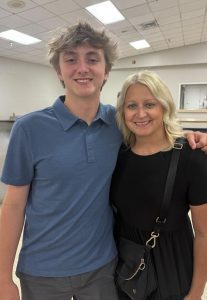
In neighboring Michigan communities, two families who had never met now share a lifelong bond – one forged in the most unexpected way: sudden cardiac arrest (SCA).
In March of 2025, during track tryouts, 14-year-old Alyssa suddenly collapsed. Coaches rushed to her side, starting CPR and using an AED. Those immediate steps saved her life. Alyssa was later diagnosed with idiopathic ventricular fibrillation (IVF) – a diagnosis made when no underlying cause can be found for a cardiac arrest. She spent nine days in the Cardiac ICU before receiving an implanted defibrillator, a device that can shock the heart if it goes into an unstable rhythm.
Her mom, Kelly, struggled to understand how this could have happened to her daughter – and felt completely alone. “A diagnosis of IVF is particularly hard, because you don’t have any concrete answers,” she says. “I felt like I was totally on my own with this, despite having great medical care. And I was afraid all the time.”
That’s when another local mom, Jen, reached out. She wanted to offer Kelly support, she said – because she wasn’t alone. Jen lived in a neighboring town, and her son, Easton, had experienced this exact same event just six months earlier.
With survival rates for out-of-hospital sudden cardiac arrest as low as 10%, Alyssa and Easton are here today because people around them knew how to act.
In September of 2024, Jen’s son, Easton, a 16-year-old multi-sport athlete at a neighboring high school, collapsed at home without warning. At first, his family thought he was having a seizure. But paramedics discovered he was in ventricular fibrillation. He endured six AED shocks, six doses of epinephrine, and continuous CPR before his heart was stabilized. Like Alyssa, Easton spent time in the Cardiac ICU and now lives with an implanted defibrillator. His diagnosis? The same: idiopathic ventricular fibrillation.
now lives with an implanted defibrillator. His diagnosis? The same: idiopathic ventricular fibrillation.
“Our family’s connection has grown into a source of comfort, strength, and shared purpose,” says Kelly.
Both families now share a mission: to raise awareness about sudden cardiac arrest in young adults, the importance of recognizing the warning signs, and the lifesaving role of CPR and AEDs. With survival rates for out-of-hospital sudden cardiac arrest as low as 10%, Alyssa and Easton are here today because people around them knew how to act.
“It’s so important for families, schools, and communities to be prepared,” says Jen. “Even if it looks like a seizure, like it did for Easton, don’t wait. Use CPR. Use an AED.”
This Sudden Cardiac Arrest Awareness Month, Kelly and Jen are sharing their family’s stories because they want others to know – you’re not alone.
“Though we live in neighboring communities and our schools often compete against each other, fate brought our families together,” says Kelly. “What are the chances that two otherwise healthy teens, living so close, would suffer the exact same life-threatening emergency within six months of one another? That connection has become a lifeline for us both, offering comfort, support, and determination to spread awareness.”
